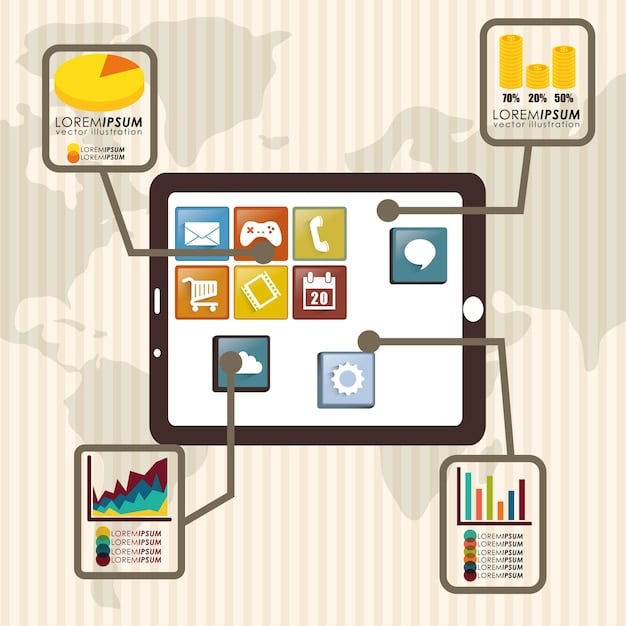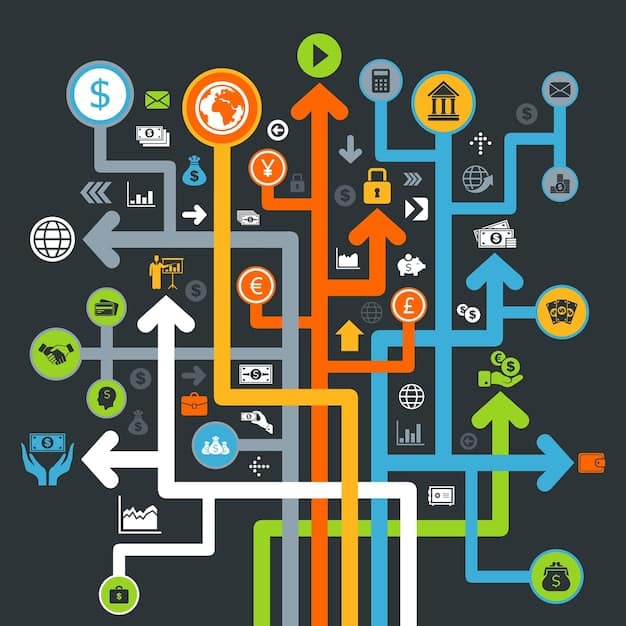How US Tech Startups Can Boost Customer Experience by 15% with Data Analytics

US tech startups can leverage data analytics to improve customer experience by 15% by personalizing interactions, predicting customer needs, and optimizing marketing efforts. This involves collecting, analyzing, and acting upon data to create more satisfying customer journeys.
In today’s competitive landscape, enhancing customer experience is paramount for the success of US tech startups. One powerful strategy is to leverage data analytics to understand customer needs better and tailor interactions effectively. But, how can US tech startups leverage data analytics to improve customer experience by 15%?
This article delves into practical approaches and real-world examples, offering actionable insights for startups aiming to elevate their customer experience through data-driven strategies.
Understanding the Power of Data Analytics in Customer Experience
Data analytics provides invaluable insights into customer behavior, preferences, and pain points. By harnessing this information, US tech startups can make informed decisions to improve various aspects of the customer journey. Let’s explore the potential benefits.
Identifying Key Customer Touchpoints
Understanding where customers interact with your brand is essential. Data analytics can help pinpoint these touchpoints and reveal areas for improvement.
Personalizing Customer Interactions
Generic interactions often fall flat. Data-driven personalization can create more meaningful experiences that resonate with individual customers.
- Analyze browsing behavior to recommend relevant products.
- Tailor email marketing campaigns based on past purchases.
- Offer personalized support based on customer history.
By focusing on these personalized touches, startups can significantly impact customer satisfaction and loyalty. This is one key aspect of how can US tech startups leverage data analytics to improve customer experience by 15% as it relates to marketing.
Data analytics allows US tech startups to understand the customer journey inside and out, paving the way for experiences tailored to drive satisfaction and loyalty. From identifying key touchpoints to personalizing interactions, the possibilities are endless.
Collecting the Right Data for CX Improvement
Effective data analytics begins with gathering the right information. US tech startups must strategically collect data that provides a comprehensive view of their customers. Let’s explore the essential data sources and collection methods.
Website Analytics
Your website is a treasure trove of customer data. Tools like Google Analytics can track user behavior, traffic sources, and conversion rates.
Customer Relationship Management (CRM) Systems
CRMs store valuable information about customer interactions, purchases, and preferences. Integrating this data with analytics tools is crucial. It also helps answer how can US tech startups leverage data analytics to improve customer experience by 15%.
Social Media Monitoring
Social media platforms provide insights into customer sentiment, brand perception, and trending topics. Use social listening tools to monitor conversations and extract relevant data.

By strategically collecting data from these sources, US tech startups can build a robust foundation for data-driven CX improvement. Remember that data privacy and compliance with regulations like GDPR and CCPA are also paramount. One key aspect of how can US tech startups leverage data analytics to improve customer experience by 15% is data privacy and adherence to regulations.
Collecting the right data is not just about volumes; it’s about the quality and relevance of the information gathered. From web analytics to CRM systems and social media monitoring, the key is to strategically gather customer data to build a robust foundation for improving customer experience and also adhere to data privacy regulations.
Analyzing Data to Uncover Actionable Insights
Once you’ve collected the data, the next step is to analyze it to uncover actionable insights. US tech startups can use various analytical techniques to identify patterns, trends, and areas for improvement.
Segmentation
Divide your customer base into segments based on demographics, behavior, or preferences. This allows for targeted marketing and personalized experiences.
Regression Analysis
Identify the factors that have the biggest impact on customer satisfaction. Regression analysis can reveal the key drivers of CX.
Sentiment Analysis
Understand how customers feel about your brand, products, or services. Sentiment analysis can be applied to social media posts, reviews, and survey responses.
- Use sentiment analysis to identify and address negative feedback.
- Analyze customer reviews to understand product strengths and weaknesses.
- Track sentiment trends over time to measure the impact of CX initiatives.
By employing these analytical techniques, US tech startups can gain a deeper understanding of their customers and identify opportunities to enhance the experience.
Analyzing data is not merely crunching numbers; it’s about extracting actionable insights that drive meaningful improvements in customer experience. The use of segmentations, sentimental and regression analysis can provide answers on how can US tech startups leverage data analytics to improve customer experience by 15%.
Implementing Data-Driven CX Improvements
The ultimate goal is to translate data-driven insights into tangible improvements in customer experience. US tech startups can implement various strategies to enhance the customer journey based on data analysis. This is where the value of how can US tech startups leverage data analytics to improve customer experience by 15% truly shines through.
Personalized Recommendations
Use data to provide personalized product or service recommendations that align with customer interests and needs.
Proactive Customer Support
Anticipate customer issues and offer proactive support based on data patterns. For example, trigger automated support messages when customers encounter specific website errors.
Optimized Marketing Campaigns
Use data to target marketing campaigns to specific customer segments and tailor messaging for maximum impact.
By implementing these data-driven improvements, US tech startups can create more satisfying and engaging customer experiences, leading to increased loyalty and advocacy.
Implementing data-driven CX improvements involves translating actionable insights into real-world strategies that enhance the customer journey. The use of proactive customer support through data, coupled with personalized marketing campaigns offers real solutions for how can US tech startups leverage data analytics to improve customer experience by 15%. These improvements lead to increased loyalty and advocacy.

Measuring the Impact of CX Initiatives with Data Analytics
Measuring the impact of CX initiatives is crucial to determine their effectiveness and ROI. US tech startups can use data analytics to track key metrics and assess the success of their efforts.
Customer Satisfaction (CSAT) Scores
Track CSAT scores over time to measure customer satisfaction with specific interactions or touchpoints.
Net Promoter Score (NPS)
Monitor NPS to gauge customer loyalty and willingness to recommend your brand to others.
Customer Lifetime Value (CLTV)
Calculate CLTV to understand the long-term value of your customers and the impact of CX initiatives on revenue.
- Use A/B testing to compare different CX strategies and measure their impact.
- Track conversion rates and sales growth to assess the ROI of CX improvements.
- Monitor customer churn rate to identify areas where CX needs attention.
By continuously measuring and analyzing these metrics, US tech startups can refine their CX strategies and maximize their impact.
Measuring the impact of CX initiatives is essential for validating their returns and ROI. By tracking customer satisfaction (CSAT) scores over time, coupled with monitoring Net Promoter Scores (NPS), US Tech Startups can assess how best to implement solutions for how can US tech startups leverage data analytics to improve customer experience by 15%. The use of A/B testing will also come in handy.
Examples of Successful Data Analytics Implementation in US Tech Startups
Learning from real-world examples can inspire and guide US tech startups in their data analytics journey. Let’s examine a few successful implementations that demonstrate the potential of data-driven CX improvement.
Case Study 1: Personalized E-commerce Recommendations
A US-based e-commerce startup leveraged data analytics to personalize product recommendations based on browsing history and purchase behavior. This resulted in a 20% increase in sales and a significant boost in customer satisfaction.
Case Study 2: Proactive Customer Support for a SaaS Company
A SaaS startup used data analytics to identify users who were struggling with specific features. They proactively offered support and guidance, leading to a 15% reduction in churn rate.
Key Takeaways and Best Practices
These case studies highlight the importance of clear objectives, robust data infrastructure, and a commitment to continuous improvement. US tech startups can emulate these success stories by prioritizing data-driven decision-making and fostering a customer-centric culture.
These case studies highlight how US tech startups can implement how can US tech startups leverage data analytics to improve customer experience by 15%. The importance of clear objectives, plus the importance of a robust data infrastructure are all essential to ensure success.
| Key Insight | Brief Description |
|---|---|
| 📊 Data Collection | Gather data from multiple sources like websites, CRM and social media. |
| 🔍 Data Analysis | Use sentiment and regressive analysis to uncover actional insights. |
| 🎯 Implementation | Translate Data-Driven Insights into measurable strategies that enhance customer journey. |
| 📈 Measurement | Track customer satisfaction scores to evaluate the effectiveness of CX initiatives. |
Frequently Asked Questions
US tech startups can implement robust data governance frameworks, comply with regulations like GDPR and CCPA, and prioritize data encryption and anonymization to ensure data privacy while leveraging analytics.
Common mistakes include collecting irrelevant data, failing to integrate data sources, and not translating insights into actionable improvements. It’s crucial to have a clear strategy and focus on data that directly impacts CX.
Start with free or low-cost tools, focus on analyzing existing data, and prioritize initiatives that offer the biggest impact. Small, data-driven improvements can lead to significant gains in CX without breaking the bank.
Key metrics include Customer Satisfaction (CSAT) scores, Net Promoter Score (NPS), Customer Lifetime Value (CLTV), and churn rate. Tracking these metrics provides insights into the effectiveness of CX efforts.
Yes, AI-powered analytics, real-time data analysis, and predictive analytics are emerging trends that can provide deeper insights into customer behavior, enabling more personalized and proactive customer experiences and helping with how can US tech startups leverage data analytics to improve customer experience by 15%.
Conclusion
Leveraging data analytics is a powerful strategy for US tech startups aiming to enhance customer experience. By collecting the right data, analyzing it effectively, and implementing data-driven improvements, startups can create more satisfying experiences that drive loyalty, advocacy, and ultimately, business success. This article explored how can US tech startups leverage data analytics to improve customer experience by 15%.





